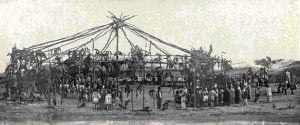Great War Dance
I shall close this paper with an account of the great war dance which was performed by all the braves which could be mustered among the five thousand Indians here assembled. The number’ who joined in the dance was probably about eight hundred. Although I cannot give the precise day, it must have occurred about the last of August 1835. It was the last war dance ever performed by the natives on the ground where now stands this great city, though how many thousands had preceded it no one can tell. They appreciated that it was the last on their … Read more



